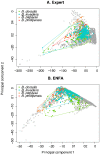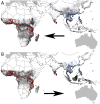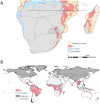Niche overlap of congeneric invaders supports a single-species hypothesis and provides insight into future invasion risk: implications for global management of the Bactrocera dorsalis complex
- PMID: 24587234
- PMCID: PMC3937438
- DOI: 10.1371/journal.pone.0090121
Niche overlap of congeneric invaders supports a single-species hypothesis and provides insight into future invasion risk: implications for global management of the Bactrocera dorsalis complex
Abstract
Background: The invasive fruit fly, Bactrocera invadens, has expanded its range rapidly over the past 10 years. Here we aimed to determine if the recent range expansion of Bactrocera invadens into southern Africa can be better understood through niche exploration tools, ecological niche models (ENMs), and through incorporating information about Bactrocera dorsalis s.s., a putative conspecific species from Asia. We test for niche overlap of environmental variables between Bactrocera invadens and Bactrocera dorsalis s.s. as well as two other putative conspecific species, Bactrocera philippinensis and B. papayae. We examine overlap and similarity in the geographical expression of each species' realised niche through reciprocal distribution models between Africa and Asia. We explore different geographical backgrounds, environmental variables and model complexity with multiple and single Bactrocera species hypotheses in an attempt to predict the recent range expansion of B. invadens into northern parts of South Africa.
Principal findings: Bactrocera invadens has a high degree of niche overlap with B. dorsalis s.s. (and B. philippinensis and B. papayae). Ecological niche models built for Bactrocera dorsalis s.s. have high transferability to describe the range of B. invadens, and B. invadens is able to project to the core range of B. dorsalis s.s. The ENMs of both Bactrocera dorsalis and B. dorsalis combined with B. philipenesis and B. papayae have significantly higher predictive ability to capture the distribution points in South Africa than for B. invadens alone.
Conclusions/significance: Consistent with other studies proposing these Bactrocera species as conspecific, niche similarity and overlap between these species is high. Considering these other Bactrocera dorsalis complex species simultaneously better describes the range expansion and invasion potential of B. invadens in South Africa. We suggest that these species should be considered the same-at least functionally-and global quarantine and management strategies applied equally to these Bactrocera species.
Conflict of interest statement
Figures





Similar articles
-
The potential distribution of Bactrocera dorsalis: considering phenology and irrigation patterns.Bull Entomol Res. 2016 Feb;106(1):19-33. doi: 10.1017/S0007485315000693. Epub 2015 Oct 21. Bull Entomol Res. 2016. PMID: 26487373
-
Biogeography, Speciation and Taxonomy within the genus Bactrocera Macquart with application to the Bactrocera dorsalis (Hendel) complex of fruit flies (Diptera: Tephritidae: Dacinae).Zootaxa. 2022 Sep 29;5190(3):333-360. doi: 10.11646/zootaxa.5190.3.2. Zootaxa. 2022. PMID: 37045165
-
Historical perspective on the synonymization of the four major pest species belonging to the Bactrocera dorsalis species complex (Diptera, Tephritidae).Zookeys. 2015 Nov 26;(540):323-38. doi: 10.3897/zookeys.540.6028. eCollection 2015. Zookeys. 2015. PMID: 26798266 Free PMC article. Review.
-
Comparative sensitivity to methyl eugenol of four putative Bactrocera dorsalis complex sibling species - further evidence that they belong to one and the same species B. dorsalis.Zookeys. 2015 Nov 26;(540):313-21. doi: 10.3897/zookeys.540.6099. eCollection 2015. Zookeys. 2015. PMID: 26798265 Free PMC article.
-
Invasive phytophagous pests arising through a recent tropical evolutionary radiation: the Bactrocera dorsalis complex of fruit flies.Annu Rev Entomol. 2005;50:293-319. doi: 10.1146/annurev.ento.50.071803.130428. Annu Rev Entomol. 2005. PMID: 15355242 Review.
Cited by
-
Thermal Biology and Seasonal Population Abundance of Bactrocera dorsalis Hendel (Diptera: Tephritidae): Implications on Pest Management.Int J Insect Sci. 2019 Aug 25;11:1179543319863417. doi: 10.1177/1179543319863417. eCollection 2019. Int J Insect Sci. 2019. PMID: 31488955 Free PMC article.
-
Predicting the current potential and future world wide distribution of the onion maggot, Delia antiqua using maximum entropy ecological niche modeling.PLoS One. 2017 Feb 3;12(2):e0171190. doi: 10.1371/journal.pone.0171190. eCollection 2017. PLoS One. 2017. PMID: 28158259 Free PMC article.
-
Global Potential Distribution of Bactrocera carambolae and the Risks for Fruit Production in Brazil.PLoS One. 2016 Nov 10;11(11):e0166142. doi: 10.1371/journal.pone.0166142. eCollection 2016. PLoS One. 2016. PMID: 27832144 Free PMC article.
-
Potential Distribution and the Risks of Bactericera cockerelli and Its Associated Plant Pathogen Candidatus Liberibacter Solanacearum for Global Potato Production.Insects. 2020 May 12;11(5):298. doi: 10.3390/insects11050298. Insects. 2020. PMID: 32408479 Free PMC article.
-
Evidence of niche shift and invasion potential of Lithobates catesbeianus in the habitat of Mexican endemic frogs.PLoS One. 2017 Sep 27;12(9):e0185086. doi: 10.1371/journal.pone.0185086. eCollection 2017. PLoS One. 2017. PMID: 28953907 Free PMC article.
References
-
- Ziska LH, Blumenthal DM, Runion GB, Hunt ER, Diaz-Soltero H (2010) Invasive species and climate change: an agronomic perspective. Clim Change 105: 13–42.
-
- Lounibos LP (2002) Invasions by insect vectors of human disease. Ann Rev Ent 47: 233–266. - PubMed
-
- Richardson DM, Pyšek P (2006) Plant invasions: merging the concepts of species invasiveness and community invisibility. Prog Phys Geog 30: 409–431.
-
- Blackburn TM, Pyšek P, Bacher S, Carlton JT, Duncan RP, et al. (2011) A proposed unified framework for biological invasions. Trends Ecol Evol 26: 333–339. - PubMed
Publication types
MeSH terms
LinkOut - more resources
Full Text Sources
Other Literature Sources
Miscellaneous

